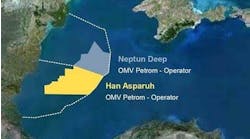Freeport-McMoRan Energy LLC, a subsidiary of McMoRan Exploration Co., has submitted a license application to develop a $440-million liquefied natural gas (LNG) receiving terminal at its Main Pass Energy Hub (MPEH) in the Gulf of Mexico 37 mi east of Venice, Louisiana. The proposed terminal would be capable of receiving and conditioning 1 bcf/d of LNG and is being designed to accommodate potential future expansions.
McMoRan plans to develop cavern storage and pipeline interconnects to the US pipeline distribution system to allow natural gas storage capacity using a massive salt dome located at the Energy Hub site. The system would provide suppliers with access to natural gas markets in the US. Aggregate peak deliverability from the terminal, including deliveries from storage, would total 2.5 bcf/d.
An application has been filed under the US Deepwater Port Act, which was amended in 2002 to include deepwater gas ports and contains a 356-day review period for a decision on the issuance of a license. The license process is under the administration of the US Coast Guard.
MPEH is in Main Pass block 299 in 210 ft of water, which allows deepwater access for large LNG tankers and is close to shipping channels. McMoRan will use the block's existing platforms and infrastructure, which were designed to withstand a 200-year storm event, to locate the LNG aporization and surface storage facilities. The use of existing facilities will provide significant construction timing advantages and cost savings. The facilities could be operational by late-2007, which would make MPEH one of the first US offshore LNG facilities. Safety and security aspects of the facility are enhanced by its remote location, the developers say.
MPEH is being designed to include cavern storage of natural gas using a 2-mi-diameter salt dome. The ability to offer natural gas storage, which would initially include 28 bcf of cavern storage, offers opportunities to achieve added value for LNG imports and provides security of supply and peaking capabilities for downstream customers. Peak deliverability for the regasification and storage facilities would total 2.5 bcf/d.
McMoRan continues to pursue commercial arrangements for the facilities and has been engaged in discussions with potential LNG suppliers and natural gas consumers. McMoRan said it expects to advance these discussions in parallel with the permitting process. The developers say the project would provide economic benefits for Louisiana and would create up to 1,300 direct jobs during the construction phase and 18,000 by the direct and secondary spending during construction. Once operational, the project is estimated to result in 1,000 direct and secondary jobs. Additionally, the direct and secondary impact of the facility is estimated at $4 billion over the life of the project.
(3/1/04)


